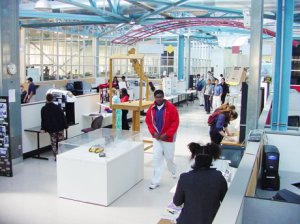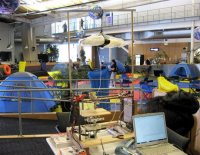How to Make Your Classroom a Thinking Space
Your content has been saved!
Go to My Saved Content.Editor's note: The following is an excerpt from Thinking Through Project-Based Learning: Guiding Deeper Inquiry by Jane Krauss and Suzie Boss. It was published this month by Corwin.
Take a moment and imagine a creative work environment. Don't worry about the kind of work going on. Just focus on the space. Close your eyes and picture it. What is that space like? What does it sound like? How are people interacting? Is there movement? Is there evidence of work in progress? Is it tidy, or busy-messy? Can you imagine working there?
Was your mental picture anything like either of the workspaces shown in these photos? People in both environments appear to be engaged and productive, using flexible, light-filled workspaces that invite collaboration. It's likely that they are accomplishing significant work, too. The image at the the very top of this page is of the Google offices. The one just below was taken at High Tech High, part of a network of public charter schools in San Diego, California. Like many schools emphasizing project-based learning, High Tech High has designed workspaces specifically to foster creativity and innovation, allow for productive collaboration, and showcase student work in curated exhibits.

Think back to your mental image of a creative workplace. Was the place you imagined a school? If the answer was "no," why not? School is a work place for 55 million people in the United States where 51.5 million student "workers" and 3.5 million teachers are charged with shaping the future. That's a big job. That's work!
Fine-Tune the Physical Environment for PBL
Birkdale Intermediate School in New Zealand has a long tradition of teaching through inquiry projects. A special flag goes up outside the school at the start of each new project to herald the launch of a learning adventure.
This school has intentionally developed a climate and curriculum to encourage deep thinking, which is reflected by the physical environment. Because the school values collaboration, it has built "nests" where small teams can work. Like glass-walled study rooms in a university library, nests are soundproofed spaces tucked between classrooms with windows that allow teachers to keep track of what's happening. Birkdale Principal Richard Coote describes these as "semi-supervised spaces," where up to a dozen students at a time can enjoy a degree of independence. Working in the nest, students might brainstorm solutions to a problem, rehearse for a public presentation, construct a model, or have a script meeting to plan what they will say. They can engage fully in teamwork without disrupting their classmates.
Many schools don't have budgets for this kind of wholesale remodeling. Yet with no-frills classroom makeovers, teachers can better accommodate the needs of project-based learning and teaching. We've seen schools that have painted interior walls with whiteboard paint, creating giant canvases for capturing and sharing ideas. To encourage students to make their thinking visible, some teachers encourage students to write on their desks or the floor with dry-erase markers or provide them with mini-whiteboards cut from melamine shower board to use while tackling problems that may require multiple attempts to solve.
Small adjustments in the learning environment will better accommodate the various tools and patterns of interaction that come into play during projects. Let's look more closely at a few patterns you can expect during projects, along with affordable solutions to accommodate them.
Independent work. A PBL classroom is busy. Sometimes students need "cave" space, a place quiet and free from distraction. Create three-panel cardboard "carrels" to separate desk or tabletop spaces for quiet work.
Partner and small-group work. Collaboration is the norm in the PBL classroom. Furnish with tables or arrange desks into groupings, or "pods." Make room dividers from standing chalkboards or whiteboards. Hang melamine shower panels that not only divide the space but serve as inexpensive whiteboards, too. See the library, hallways, entryways, courtyards, and even the office as potential learning spaces. One principal we know lets students work in his office. (He's a rover who is often in classrooms and hallways.) Set expectations with everyone involved for what happens in these out-of-classroom settings, including how you will monitor student conduct. Gradually release the reins as students demonstrate good self-management in more independent situations.
Check-ins and seminars-for-some. During projects, teachers check in with teams and offer seminar-style lessons on tightly focused topics (for example: how to cite sources for a research project, prepare for an interview with an expert, or make a podcast). Nic Carroll and Kyle Jones, who teach in a PBL studio at North Gwinnett High School in Georgia call their mini-lessons "coffee talks." Optional for all but mandatory for some (based on the teachers' formative assessment), coffee talks are informal and friendly. If your classroom can accommodate soft benches or couches, this arrangement is perfect for mini-lessons and small-group discussions.
Reimagine who the stuff belongs to. We have seen classrooms in which resources are only used by the teacher or under the teacher's direction. Smart boards and document cameras are great for making thinking visible. Are your students using these tools for brainstorming, diagramming, and other kinds of group thinking?
Conversational classroom. Being "front and center" lends authority but can hamper interaction. When you stand at the front of the class, student interaction will tend to flow through you. Change things up. Put chairs in a circle, join the group, let a student lead, and encourage classmates to converse with each another, not just with you.
Student presentations. Funny how we recommend that teachers lecture less, yet students' expressions of learning in projects are frequently one-way presentations-basically, lectures. Encourage your students to move out of the front of the classroom, too, and engage their audience in participatory activities like team challenges, game-style events, gallery walks, or hands-on engagement with materials.
Tinker station. Encourage hands-on, minds-on creative thinking by providing tools for tinkering. Stock a "maker" station with everything from Legos to kits with wires, switches, and batteries, to a sewing machine. Add a library of Make, Craft, and Popular Mechanics magazines to get creative juices flowing.
Skype on. Whenever his class works on a collaborative project with another school, a veteran PBL elementary teacher named Terry Smith keeps a Skype chat line open on a dedicated computer. Even when they are not conversing, students working at a distance stay tethered through the chat function and can hop on calls as needed with a "ping."
Video booth. Turn an empty refrigerator box into a three-sided video booth to capture student reflections. In one class, students created posters on the interior walls that evoke the themes of each project. You might set up lighting and a video camera on a tripod, or just arrange for video capture through a webcam.
Color. If you have the option of changing wall colors in your classroom and school, investigate the role of color on minds and bodies. Better yet, have students investigate and make color recommendations as part of a project.
Furniture. As with color, furniture affects body and mind. Kids have a natural inclination to move, and ergonomic furniture designs (round-bottom stools or shell-shaped chairs that rock) accommodate rather than suppress movement. Beanbag chairs invite students to settle in for reading or quiet work.
What's on Your Wish List?
Teachers model creative thinking when they find workarounds or inexpensive fixes to make their classrooms more conducive to project work. They also model collaboration if they enlist parent volunteers and other community members to help. Put your creativity to work by imagining how you might improve your classroom environment to invite good thinking. What belongs on your PBL wish list? How might you make it happen?
We look forward to hearing your ideas in the comments.
